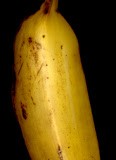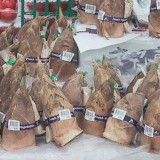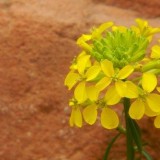 |
| Black Nightshade (Solanum nigrum) |
The issue of the edibility of black nightshade (Solanum nigrum) came up in the comments on our post on forager Pascal Baudar. We’ve blogged about the confusion between the edible Solanum nigrum and the toxic “deadly nightshade” or Atropa belladonna in a post last year. But Pascal left a link to an excellent article by author and forager Sam Thayer that puts in the nail in the coffin of the myth that Solanum nigrum is poisonous.
 |
| Deadly Nightshade (Atropa belladonna) |
Two lessons here. As Thayer puts it, “myths of toxicity are commonplace (in fact, I’d argue that they are a universal feature of human culture) while myths of edibility are exceedingly rare, since they are soon discredited.” I strongly suspect that there are many other plants wrongly accused of toxicity. Remember that tomatoes were long thought poisonous, in part due to similarities in appearance to Atropa belladonna, and associations with witchcraft.
The second lesson is the importance of using scientific not popular names when describing plants. Much of the confusion surrounding Solanum nigrum is caused by “experts” confusing it with Atropa belladonna due to the similarity between both the appearance of the plant and the popular names. Solanum nigrum is, by the way, much more commonplace.
Unripe (green) fruit of Solanum nigrum does contain solanine and should be avoided, but the ripe fruit is perfectly edible and quite delicious. People all around the world eat Solanum nigrum. In parts of the US Solanum nigrum berries are made into pies. I’ve snacked on Solanum nigrum berries from the backyard and I was lucky to be served Solanum nigrum prepared in a balsamic reduction sauce by Pascal’s partner Mia Wasilevich…and I’ve lived to tell the tale!





I can vouch for it not being poisonous, because my parents are alive! They grew up in Taiwan, and as kids they would pick the ripe berries and eat them (they grew up in the countryside). These have popped up in my yard (not sure if my dad purposefully planted them or not) and for the longest time I thought they were deadly nightshade and kept pulling them up. My dad looked at me like I was crazy lol.
When I lived in Wyoming, Huckleberries (they looked like the Solanum melanocerasum offered in seed catalogs) grew wild and were picked and made into pies. Local lore there said that they were originally planted by the Germans from Russia, who settled in the area in the late 19th and early 20th centuries. They are OK, but not particularly tasty.
Are you kidding me?? I just took exactly that into Armstrong and they told me it was poisonous so I pulled it up. It just came up in my garden – no idea where from. Oh if only you had posted this two weeks ago! 🙁 Maybe it’ll pop up again next year…
It has a tendency to pop up. I’ve got some that came up out of the compost.
I think I just pulled a bunch of this out today. The berries were not ripe yet, but everything else looks exactly the same.
I’ve had these pop up in my garden a lot lately…I tasted it and decided it wasn’t worth the space it was trying to take from the basil. If it didn’t try to grow in all the best spots I’d leave it for garden snacking.
Do you ever eat the leaves? A local restaurateur told me his wife puts the leaves in soups. Seems like it could substitute for spinach. We have a ton of it growing in our
Tomato bed right now; I’ll have to harvest the ripe berries and make a dessert!!!
I’ve never tried the leaves. In the article I linked to, Thayer says that black nightshade greens could be the most widely eaten greens in the world. Oddly, many westerners continue to suggest that the greens are poisonous despite the fact that you can buy them in markets all over Asia and Central America.
My mother and my sister eat both the green/raw fruits and leaves. They love to dip those on hot souce, or crush the raw berries mixed with other ingredient and eat raw too. I personally never tried it.
It is good central Americans use in soup, like spinach is called MORA or Yerva mora,. in my house in Los Angeles grow in my compost and every place that like weed. but I do not know if I should eat it,
Lots of Central American people in my community garden grow it in their plots — apparently the leaves are very high in iron… They say the berries are poisonous, but good to hear they aren’t!
ahh dammit. and here I am tearing it out every few days…. woe is me.
Is this the same as “wonderberries”? If so, they are NOT delicious and will become a weed! I’ve even read they they are superior tasting to the Black Night Shade…If that’s the case, STAY AWAY because the wonderberries are not wonderful! I tried wonderberries a few years ago, they’re not very good plain and now I find them all over my yard and garden. I live in southern New Hampshire, BTW.
Looks like “wonderberries” (there’s marketing for you!) are Solanum burbankii, not Solanum nigrum.
we all have our different tastes, I like native gooseberries but most everyone i share them with are disgusted.
Wow, I am so glad you posted this. We have this growing in our balcony garden (no idea where it came from). I popped off one of the still green berries one day, opened it, and smelled it. I thought it smelled like cerise de terre, so I assumed it was some kind of tomato-related plant. When I did some research, everything I found said that it IS poisonous! But now I’m unsure of whether we have:
http://en.wikipedia.org/wiki/Solanum_americanum
or
http://en.wikipedia.org/wiki/Solanum_nigrum
I’ll try to figure it out. I almost ripped out the plant because I have small children and so do all my friends. I wonder what the defining differences are between the two.
Correction to my earlier comment–Wikipedia says the americanum one is poisonous and has killed children. But it looks more like the one I have, I think.
I’d not heard of americanum, so went looking and found this great article:
http://www.eattheweeds.com/american-nightshade-a-much-maligned-edible/
It has tips on distinguishing the two. And it also highlights how very confusing questions of toxicity can be.
All is all, solanum is a tricky family, and needs to be approached with great care.
Wow, that article looks super helpful–thanks! I’ll have to sit down and look carefully at what we have.
We had some pop up in the garden a few years ago. My husband thought it was a tiny tomato :), but after some research we found just what you say here that it’s a member of the nightshade family (like tomato and potato), is not poisonous, and tastes a bit like tomato.
It was funny that it just popped up. I have no idea where it came from :).
I have eaten a leaf from the Solanum Nigrum.I would not recommend anyone to do this.The stomach cramping and purgatory action will last for days.The black berries are sooo good though.
My parents eat the leaf of the plant and I grew up eating it! Its actually my favorite green of all time! I moved away from home and cannot find any to eat 🙁 I crave it soo much! I only get to eat it once a year when I go visit my parents in Oregon.
You only eat the young tender leaves, not the berry or the flowers and you must cook it! I don’t recommend eating it raw.
Hmmm… only found out the name of this vegetable last month so decided to look it up. Here in Nagaland, North East India, it is a much sought after vegetable…from what i can tell from looking at online pics the ones we eat are the Solanum trilobatum and Solanum sodomeum, we call the small berries Likok, while the larger varieties are called Taku(meaning bitter) we prefer it to be as bitter as possible so unripened ones are cooked or made into pickles and chutneys. Very tasty…
I’ve eaten the leave my whole life and I am still here today. What we do is pick the plant, leaves and stem only, then wash them. Prepare some water with a pinch of salt, heat the water and keep it at a simmer. Simmer the plant for 3 to 5 minutes. When the plant is soft and the water has turned a dark, but still translucent, green, it’s done cooking. The taste of the liquid and plant will have a slight bitter taste, its taste absolutely wonderful with some white rice.
Hi, I just wanted to say that my boyfriend is Guatemalan and he makes soup made from solanum nigrum, in spanish the plant is called yerba mora. The thing is, the last time he ate the soup, he said he started feeling weird and saw things and heard things that werent there, he told me this story before I knew exactly what plant he was talking about. Now I am wondering if he is confused about which plant he cooked or if he ate too much and got a little sick? His experience was not what he was expecting after eating soup. 🙂
I have this in my garden and have been plucking the ripe berries each alternate day i see. They taste well and i am live, posting image. I understand that this is called “Kashi Soppu” in our part of the world i.e. Bangalore, Karnataka, India and has medicinal properties. This cures stomach ailments.
I found this plant in my garden and was always wondering whether the fruits are edible. Its flower and fruit look just like that of small eggplant/aubergine. So I guessed a Chinese name and searched on the internet. I found the exact photos of the plant. According to Chinese herbal medicine, the whole plant is edible and good to our body and health.
I have this in my horse pasture I tasted a berry today and it was very sweet and was like a Blue Berry. It has tiny seeds inside just like blue berries. I will make sure tomorrow and have our extention agent look at it for me.
Am from South africa and my grannies used to cook jam with the ripe berries. We were always told to stay away from the green berries as it caused vomiting and diarrhea , and the indigenous people ccoked the leaf tips as a vegetable but it was bitter and felt slimey like snot. I have a Kenyan friend who told me they used to cook it over two weeks by boiling it twice a day and every time adding a little bit of cream or milk to it. Bear in mind that this is from rural rural Kenia where there are no fridges. He says the cooking twice a day was to kill bacteria. Why the process took two weeks he cannot explain but says is the best thing he has ever eaten.
Thanks for sharing. A recipe that takes two weeks–amazing!
Many scientific studies have been made into the toxin content of Solanum nigrum and related plants. They consistently report solanum toxins to be present in these plants, including S. nigrum. The fact that many of you eat it without illness doesn’t mean it’s toxin-free or safe, just that you’ve not received a high enough dose to give symptoms. Solanum toxin levels vary dramatically with the part of the plant, its maturity (eg mature berries are low in toxin), and exposure to light. Solanums poison many many grazing cattle every year.
Pingback: Strange mini bell pepper
My father consumed these berries from his garden thinking they were harmless, however suffered severe reactions from these and was admitted into hospital with stroke like symptoms including paralysis, inability to communicate, severe hallucinations, tightness of muscles and severe pain etc.. Today is day 5 since he has been in hospital whereby the affects are slowly wearing off, and it now appears he is past the worst of it.
In short *DO NOT CONSUME THESE BERRIES*
Based on my experience Black Nightshade (Solanum nigrum) is definetely *NOT* Edible
My father suffering from leaver cancer in advance stage some body tell me to use the solanum nigrum leave to eat and the boil water can use it
read my above post – you have been warned, I would speak to a qualified health professional regarding your fathers ailment rather than seek advice here.